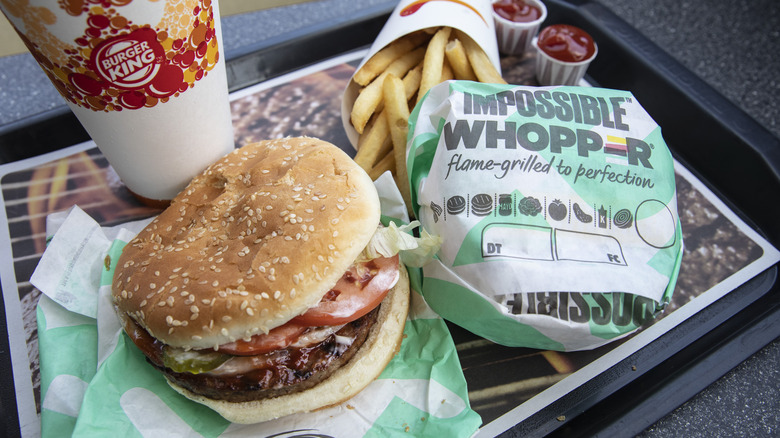Whopper Vs. Impossible Whopper: What's The Difference?
The Whopper, Burger King's signature hamburger, has been around since 1957 — more than 60 years (via Mashed). Known for its quarter-pound, flame-grilled beef patty, nothing about the chain's creation hinted towards a future in anything related to vegetarian. Just beef, and a lot of it. Even with all of the Whopper's variations over the years — from 2008's Angry Whopper to 2016's Whopperito and even the Upside Down Whopper in 2018, per the National Franchise Association — the burger's beef was the one thing that always remained. But, in 2019, that all changed with their partnership with Impossible Foods.
Burger King launched the Impossible Whopper — a hamburger with all the classic pairings of a regular Whopper, including the mayo, sliced white onions, crispy lettuce, tomatoes, ketchup, crunchy pickles, and sesame bun (via Burger King). Except this variation had one major difference: the quarter pound fire-grilled beef patty that gave the Whopper its name in 1957 was no more. This time, the Whopper's classic beef patty was replaced by a plant-based version from Impossible Foods. The substitution allowed Burger King to maintain its signature hamburger's look, feel, and taste while curbing carbon emissions and catering to vegetarians.
According to VegNews, by choosing an Impossible Whopper over a traditional Whopper, Burger King's customers saved as much greenhouse gas emissions as it'd take to drive 520 million miles — which was in the year 2020 alone. But is the Impossible Burger as good for you as it is for the environment?
Cholesterol vs. sodium
Nutritionally, there are some key differences between Burger King's Impossible Whopper and the traditional Whopper. Both deliver around 30 grams of protein and around 60 grams of carbohydrates. Although the Impossible Whopper contains fewer calories, where it really stands ahead of the traditional Whopper is in its cholesterol and fiber content. Compared to the traditional Whopper's 90 milligrams of cholesterol, the Impossible Whopper comes in at around six times less. Additionally, the Impossible Whopper has more than double the fiber than a traditional Whopper — with nearly 7 grams compared to the traditional Whopper's 3 grams.
However, sodium is one department where the Impossible Whopper falls short. While both options are high in salt, the Impossible Whopper has about 180 more milligrams. Most of that additional sodium can be attributed to the fact that, according to Fueled By Science, classic beef patties contain around 80 milligrams of sodium while most plant-based patties contain about 370 milligrams — and that number is right on par with the amount found in an Impossible burger patty (via Impossible Foods). It's an important element to consider before seasoning plant-based meat, which could explain the remaining 110 milligrams of additional salt.
But does all that salt outweigh the good? Not necessarily. With less cholesterol and more fiber, it's still slightly healthier than a traditional Whopper — but the difference is so small that Fast Food Nutrition doesn't consider it a healthy alternative. Really, it just seems better for the planet. And, you know, it's a good option for people who don't want to eat meat.

